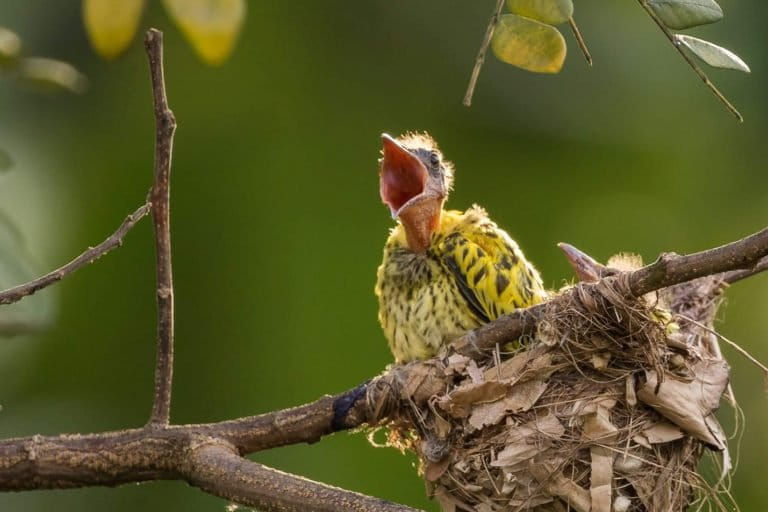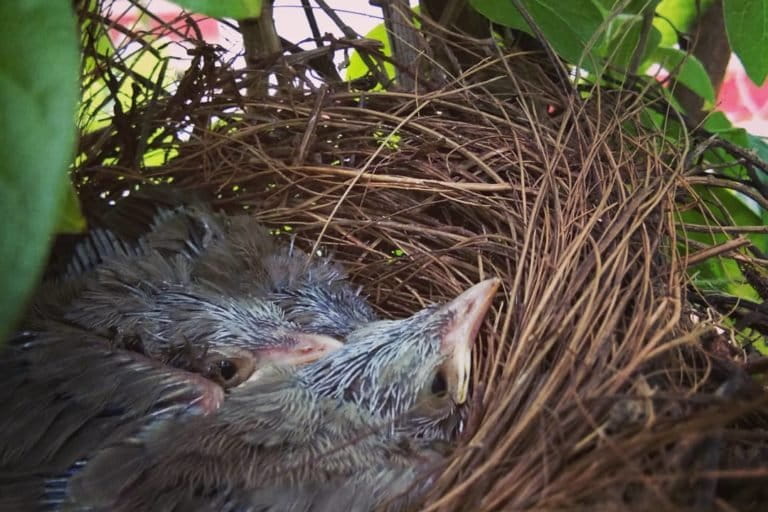Sri Lankans find a digital helping hand for baby birds fallen from nests
Jun 20, 2021
- Nesting season for Sri Lanka’s birds, which runs from February to May and coincides with the start of the monsoon, often sees chicks falling out of nests, being orphaned, or attacked.
- Sri Lanka also has a long and strong tradition of goodwill toward birds, with many households setting up feeders and bird boxes in their gardens.
- This year’s nesting season has seen people locked down at home by the COVID-19 pandemic turning to online sources for help caring for fallen, injured or displaced chicks.
- Bird-watching has also increased in popularity, aided by digital platforms and apps such as eBird and Merlin that help register bird sightings and identify different species.
COLOMBO — Folklore has it that babies were delivered by storks, who carried them in slings from their beaks and left them at the door of unsuspecting couples. But the script was flipped for Premathilaka Peramuna, who opened his door in the town of Baduraliya, in western Sri Lanka, to find a chick huddled inside a cardboard box.
The bird hadn’t grown its flight feathers yet, but a yellow line on its wing indicated it was an endemic Sri Lanka green pigeon (Treron pompadora). Peramuna didn’t know how to look after the young bird, so he handed it over to his friend for nursing.
At a different location in western Sri Lanka, Manori Gunawardena found a tiny bird about a day or two old. She tried to find the chick’s parents, but couldn’t locate any nest nearby. The chick was immature and needed special care, so Gunawardane considered handing it over to a wildlife rescue center managed by the Department of Wildlife Conservation (DWC). But the area where the center is located is under a COVID-19 lockdown, so she was unable to get help. She took the chick home and placed it near her table lamp for extra warmth, and sought instructions from her veterinary colleagues on how to care for the bird.

Pramitha Pasquel’s experience was different. The areca palm tree in front of his house had a hole occupied by a family of brown-headed barbets (Psilopogon zeylanicus). Strong monsoonal winds brought the tree down along with the nest, in it were an egg and a fledgling born just a few hours earlier. As the mother bird descended to the ground to inspect the nest, she was attacked by a cat. Pasquel managed to save the bird, but its right wing was badly injured. Unable to take the bird to a vet, he searched the internet for help.
“I received many calls from concerned people seeking advice on how to take care of orphaned or injured fledgling birds,” said Rukmal Rathnayake, an independent ecologist who advised Pasquel on how to help the injured bird. A biology graduate from the University of Colombo, Rathnayake doesn’t have any formal veterinary training, but he has plenty of experience caring for injured or abandoned birds. He freely shares this knowledge on several platforms on bird rescues, hoping to educate the public on responding to emergencies.
“People need to develop a bit of practical knowledge to assist chicks that land in their gardens this way,” Rathnayake says. For example, people often try feeding the birds sorghum grain, which is typical pet food in Sri Lanka for kittens or puppies. “It is important to understand bird diets and that’s mostly fruits, nuts and sometimes meat,” Rathnayake told Mongabay.

Fallen feathered friends
February to May marks the nesting season in Sri Lanka. It also coincides with the start of the seasonal monsoon, which brings stormy conditions that can blow nests out of trees, or even fell an entire tree.
Some of the birds that often nest in home gardens across Sri Lanka include the red-vented bulbul (Pycnonotus cafer), yellow-billed babbler (Argya affinis), spotted dove (Spilopelia chinensis), black-hooded oriole (Oriolus xanthornus), oriental magpie-robin (Copsychus saularis), rose-ringed parakeet (Psittacula krameri), common tailorbird (Orthotomus sutorius) and brown-headed barbet. They have different diets and different requirements based on their age, Rathnayake added.
“In recent weeks, we’ve had many injured and orphaned birds being handed over by those who dared to do so despite travel restrictions due to the pandemic,” said Suhada Jayawardana, veterinary surgeon at the Wildlife Rescue Center in Attidiya in western Sri Lanka. “Some of them were so weak and haven’t survived, but we successfully have revived many,” he said.
Sri Lankans have close cultural associations with birds and are generally compassionate toward them, says Sarath Kotagama, emeritus professor of ecology and chair of BirdLife Asia and council member of BirdLife International. Many households maintain bird feeders, a custom that has survived centuries and is linked to traditional farming practices, when birds were reserved a small area of the cultivation to feed on, known as the kurulu paluwa.
Birds have a significant presence as cultural symbols with strong links to literature and religion in Sri Lanka, Kotagama told Mongabay.

There are a number of traditional dances based on the movements and characteristics of birds, such as the Mayura Wannama, inspired by the peacock. There are also messenger poems that form a significant part of Sinhalese literature known as sandesha kavya, which refers to how birds were used as messengers. Villagers have made their weather predictions based on the behavior of birds: low- flying swallows, for instance, indicated the onset of rain. Similarly, villagers believed cawing crows heralded visitors, particularly relatives, and if a devil bird was heard, there would be a death in the village.
Only a few decades ago, many Sri Lankan households had a box or a pot fixed to the outside wall of their homes, to encourage nesting by house sparrows (Passer domesticus), considered a good omen.

This long-held cultural goodwill toward birds, coupled with a strong tradition of bird-watching introduced during British colonial rule, means many people continue to take a protective attitude to the island’s feathered inhabitants. Sarath Kotagama in particular is credited with making birding extremely popular in recent decades, together with other field experts.
Kotagama, through his birding society, has encouraged Sri Lankans to watch garden birds during the COVID-19 lockdowns, encouraging the public to use eBird record-keeping platform to register sightings. EBird is a global initiative by the Cornell Lab of Ornithology based in U.S. and is popular in Sri Lanka.
The country was ranked 46th in the recently concluded Global Big Day 2021, a global birding event where anybody can watch birds and enter records into eBird. Sri Lanka also placed fourth among Asian countries, behind only India, Thailand and China, for its demonstrated interest in bird-watching.
Merlin, Cornell’s bird identification app, also helps birders automatically put a name to bird they see. It recently rolled out a pack specific to Sri Lanka that offers detailed information to identify the island’s birds.
Kotagama, whose pioneering bird guides written in the local language helped popularize bird-watching in Sri Lanka, welcomed the introduction of new technology in the field. He said bird identification apps such as Merlin would further help popularize birding in Sri Lanka, and enable more people to lend a helping hand to birds in need.
Banner image of a bird feeder, a direct invitation to birds to visit home gardens, courtesy of Sri Srikumar.